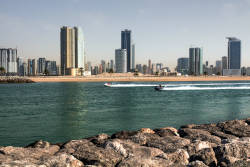
United Arab Emirates


The United Arab Emirates are a federation of seven emirates, each governed by a hereditary emir who jointly forms the Federal Supreme Council, the highest legislative and executive body in the country. The capital is Abu Dhabi, one of the two main cities, the other one is Dubai. Tourism is a growth sector for the country, the main destination is Dubai with 10 million tourists in 2013. The major tourist attractions are artificial, like the Burj Khalifa in Dubai, or the artificial islands which look like a world map or like a palm tree. There is the Sheikh Zayed Grand Mosque in Abu Dhabi, and the Yas Marina Circuit, the second of four Formula One tracks in the Middle East. Among the natural sights are the uniqueness of the country’s natural desert life and the Hajar Mountains, also known as Oman Mountains.
The Hajar Mountains have four major groups of rocks. First, pre-Permian sedimentary rocks mostly clastics, carbonates and evaporites. Second, middle Permian to Late Cretaceous continental shelf carbonates. Third, a series of nappes consisting of sedimentary rocks and late Cretaceous oceanic crust. And fourth, late Cretaceous to Miocene shallow marine and terrestrial sedimentary rock. With numerous layers of limetone, anhydrite, salt and other soluble rocks, there is a rather good potential for karstification. There are numerous caves on the Oman side, but so far almost no cave exploration and few known caves on the UAE side. Wikipedia states that the مغارة قصر حفيت (Magharet Qasir Hafee) near Al Ain is the only cave system in the UAE. That’s obviously untrue, but it is probably currently the longest known cave with a length of 450 m and a vertical range of 96 m.
As far as we know, there is currently no caving club in the country, the only association which is at least similar to a caving club is the Hazza Fazza adventurer club. They offer hikes to small caves and have transformed one cave in a sort of show cave. However, despite the trails and even electric light, the cave is actually not operated as a show cave. And as far as we know, they neither survey their caves nor publish their findings. The publications we found were done by foreign researchers.
Literature
- Nadja Hajna, Asma Al-Farraj, Farraj Ketbi, Franci Gabrovsek et al. (2013): Cave And Karst Prospection In Ras Al-khaimah Mountains, Northern United Arab Emirate, Conference: 16th International Congress of Speleology, Brno 2013. In: ICS Proceedings, Volume 3, 164-169. researchgate
- Sights of United Arab Emirates
 Al Fayah Park
Al Fayah Park Al Nahwah Cave
Al Nahwah Cave Atlantic Cave
Atlantic Cave Cave of Miracles
Cave of Miracles Palm Jumeirah Underpass
Palm Jumeirah Underpass Qasar Masafi Restaurant
Qasar Masafi Restaurant Ski Dubai Ice Cave
Ski Dubai Ice Cave Valley of the Caves
Valley of the Caves Wadi Naqab Cave
Wadi Naqab Cave Wadi Rahabah Cave
Wadi Rahabah Cave
- Additional Information about United Arab Emirates
 Search DuckDuckGo for "United Arab Emirates"
Search DuckDuckGo for "United Arab Emirates" United Arab Emirates - Wikipedia
United Arab Emirates - Wikipedia
 Index
Index Topics
Topics Hierarchical
Hierarchical Countries
Countries Maps
Maps